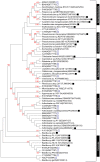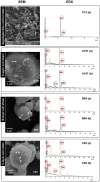Population structure of manganese-oxidizing bacteria in stratified soils and properties of manganese oxide aggregates under manganese-complex medium enrichment
- PMID: 24069232
- PMCID: PMC3772008
- DOI: 10.1371/journal.pone.0073778
Population structure of manganese-oxidizing bacteria in stratified soils and properties of manganese oxide aggregates under manganese-complex medium enrichment
Abstract
Manganese-oxidizing bacteria in the aquatic environment have been comprehensively investigated. However, little information is available about the distribution and biogeochemical significance of these bacteria in terrestrial soil environments. In this study, stratified soils were initially examined to investigate the community structure and diversity of manganese-oxidizing bacteria. Total 344 culturable bacterial isolates from all substrata exhibited Mn(II)-oxidizing activities at the range of 1 µM to 240 µM of the equivalent MnO2. The high Mn(II)-oxidizing isolates (>50 mM MnO2) were identified as the species of phyla Actinobacteria, Firmicutes and Proteobacteria. Seven novel Mn(II)-oxidizing bacterial genera (species), namely, Escherichia, Agromyces, Cellulomonas, Cupriavidus, Microbacterium, Ralstonia, and Variovorax, were revealed via comparative phylogenetic analysis. Moreover, an increase in the diversity of soil bacterial community was observed after the combined enrichment of Mn(II) and carbon-rich complex. The phylogenetic classification of the enriched bacteria represented by predominant denaturing gradient gel electrophoresis bands, was apparently similar to culturable Mn(II)-oxidizing bacteria. The experiments were further undertaken to investigate the properties of the Mn oxide aggregates formed by the bacterial isolates with high Mn(II)-oxidizing activity. Results showed that these bacteria were closely encrusted with their Mn oxides and formed regular microspherical aggregates under prolonged Mn(II) and carbon-rich medium enrichment for three weeks. The biotic oxidation of Mn(II) to Mn(III/IV) by these isolates was confirmed by kinetic examinations. X-ray diffraction assays showed the characteristic peaks of several Mn oxides and rhodochrosite from these aggregates. Leucoberbelin blue tests also verified the Mn(II)-oxidizing activity of these aggregates. These results demonstrated that Mn oxides were formed at certain amounts under the enrichment conditions, along with the formation of rhodochrosite in such aggregates. Therefore, this study provides insights into the structure and diversity of soil-borne bacterial communities in Mn(II)-oxidizing habitats and supports the contribution of soil-borne Mn(II)-oxidizing bacteria to Mn oxide mineralization in soils.
Conflict of interest statement
Figures





Similar articles
-
Carbon Metabolism of a Soilborne Mn(II)-Oxidizing Escherichia coli Isolate Implicated as a Pronounced Modulator of Bacterial Mn Oxidation.Int J Mol Sci. 2022 May 25;23(11):5951. doi: 10.3390/ijms23115951. Int J Mol Sci. 2022. PMID: 35682628 Free PMC article.
-
Surface Mn(II) oxidation actuated by a multicopper oxidase in a soil bacterium leads to the formation of manganese oxide minerals.Sci Rep. 2015 Jun 3;5:10895. doi: 10.1038/srep10895. Sci Rep. 2015. PMID: 26039669 Free PMC article.
-
Bacteriogenic manganese oxides.Acc Chem Res. 2010 Jan 19;43(1):2-9. doi: 10.1021/ar800232a. Acc Chem Res. 2010. PMID: 19778036 Review.
-
[Formation and reactions of biogenic manganese oxides with heavy metals in environment].Huan Jing Ke Xue. 2009 Feb 15;30(2):574-82. Huan Jing Ke Xue. 2009. PMID: 19402518 Chinese.
-
The molecular biogeochemistry of manganese(II) oxidation.Biochem Soc Trans. 2012 Dec 1;40(6):1244-8. doi: 10.1042/BST20120229. Biochem Soc Trans. 2012. PMID: 23176462 Review.
Cited by
-
Advances in Research on Bacterial Oxidation of Mn(II): A Visualized Bibliometric Analysis Based on CiteSpace.Microorganisms. 2024 Aug 7;12(8):1611. doi: 10.3390/microorganisms12081611. Microorganisms. 2024. PMID: 39203453 Free PMC article. Review.
-
Microbial community response reveals underlying mechanism of industrial-scale manganese sand biofilters used for the simultaneous removal of iron, manganese and ammonia from groundwater.AMB Express. 2018 Jan 8;8(1):2. doi: 10.1186/s13568-017-0534-7. AMB Express. 2018. PMID: 29313157 Free PMC article.
-
Synthesis of MnO/C/NiO-Doped Porous Multiphasic Composites for Lithium-Ion Batteries by Biomineralized Mn Oxides from Engineered Pseudomonas putida Cells.Nanomaterials (Basel). 2021 Feb 1;11(2):361. doi: 10.3390/nano11020361. Nanomaterials (Basel). 2021. PMID: 33535572 Free PMC article.
-
Influence of Intact Mycelium of Arbuscular Mycorrhizal Fungi on Soil Microbiome Functional Profile in Wheat under Mn Stress.Plants (Basel). 2022 Oct 2;11(19):2598. doi: 10.3390/plants11192598. Plants (Basel). 2022. PMID: 36235464 Free PMC article.
-
Carbon Metabolism of a Soilborne Mn(II)-Oxidizing Escherichia coli Isolate Implicated as a Pronounced Modulator of Bacterial Mn Oxidation.Int J Mol Sci. 2022 May 25;23(11):5951. doi: 10.3390/ijms23115951. Int J Mol Sci. 2022. PMID: 35682628 Free PMC article.
References
-
- Tebo BM, Bargar JR, Clement BG, Dick GJ, Murray KJ, et al. (2004) Biogenic manganese oxides: Properties and mechanisms of formation. Annu Rev Earth Pl Sc 32: 287–328.
-
- Kay JT, Conklin MH, Fuller CC, O’Day PA (2001) Processes of nickel and cobalt uptake by a manganese oxide forming sediment in Pinal Creek, globe mining district, Arizona. Environ Sci Technol 135: 4719–4725. - PubMed
-
- Tebo BM, Johnson HA, McCarthy JK, Templeton AS (2005) Geomicrobiology of manganese(II) oxidation. Trends Microbiol 13: 421–428. - PubMed
Publication types
MeSH terms
Substances
Associated data
- Actions
- Actions
- Actions
- Actions
- Actions
- Actions
- Actions
- Actions
- Actions
- Actions
- Actions
- Actions
- Actions
- Actions
- Actions
- Actions
- Actions
- Actions
- Actions
- Actions
- Actions
- Actions
- Actions
- Actions
- Actions
- Actions
- Actions
- Actions
- Actions
- Actions
- Actions
- Actions
- Actions
- Actions
- Actions
- Actions
- Actions
- Actions
- Actions
- Actions
- Actions
- Actions
- Actions
- Actions
- Actions
- Actions
- Actions
- Actions
- Actions
- Actions
- Actions
- Actions
- Actions
- Actions
- Actions
- Actions
- Actions
- Actions
- Actions
- Actions
- Actions
LinkOut - more resources
Full Text Sources
Other Literature Sources

